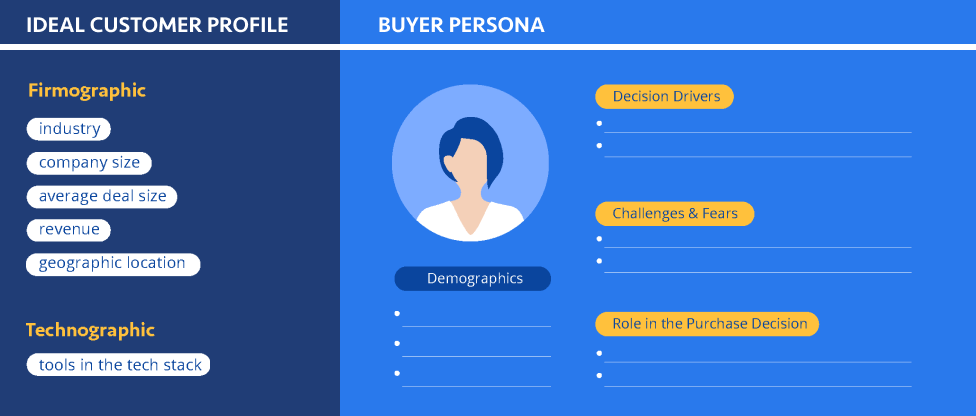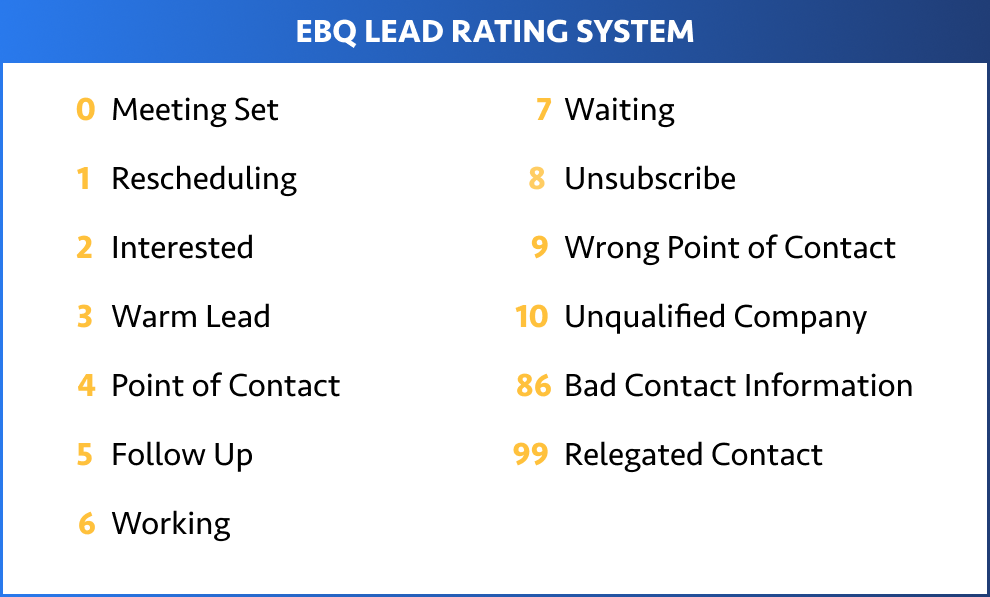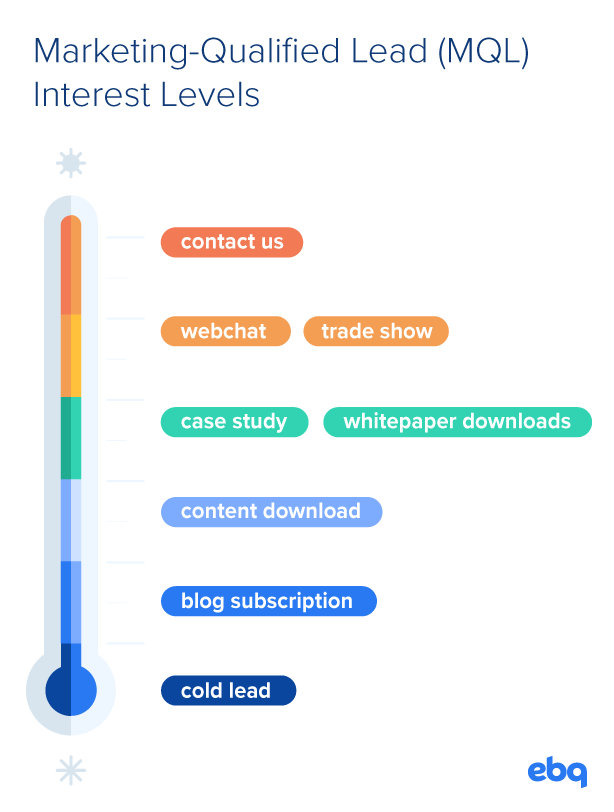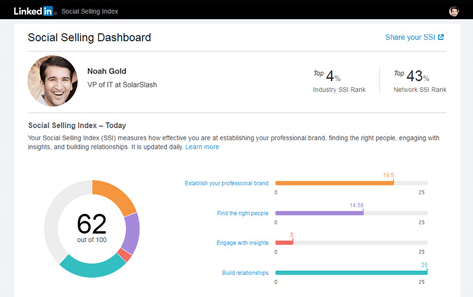Prospecting is a critical function of any B2B sales organization, but it takes some strategic planning to make sure you’re pursuing the right buyers and not wasting time on people who aren’t likely to buy.
In this article, we’ll provide some of the best prospecting strategies for modern sales organizations.
1. B2B Prospect Lists
A B2B prospect list is a record of contacts and companies that are a good fit for your product or service, which gives your sales team direction for who they should be reaching out to. Prospect lists are typically built out and maintained in a database or CRM platform like Salesforce, so it can be updated as needed when more information is gathered about the prospects.
Before you can build a prospect list, you need to identify what types of companies and buyers you should target. This starts with building out your ideal customer profile and buyer personas.

- Industries & verticals: What industries are likely to use your solution? Identify specific verticals within those industries.
- Company size: Enterprise, small-to-medium businesses, or startups? How many employees?
- Annual revenue: Often another indicator of company size. What does ARR look like for companies who invest in your solution?
Who should you contact at those companies?
- Job level: Is the decision to purchase your product made by top-level executives, like VPs and directors? Or do you have better luck pursuing power users who influence the purchase decision, like managers? In many cases, you may need to call on both top-level executives with buying power and lower level specialists who deal directly with the problem your product solves.
- Business unit: Is your solution better suited for a certain department in the organization, like marketing or IT?
Figuring out who your ideal buyers are involves looking at historical customer data, conducting primary research (targeted outreach, interviews, focus groups, etc.), and digging into third-party market research. Read EBQ’s post about defining buyer personas for more guidance here.
Account-based prospecting strategy
The most important aspect of your B2B prospect lists is that they’re highly targeted toward the people and organizations that have the highest probability of purchasing what you offer.
Many B2B companies, especially ones with high-cost offerings and enterprise customers, implement an account-based sales strategy. Instead of casting a wide net by targeting a type of company or buyer, they target specific companies that have been identified as potential customers.
An account-based strategy gives your reps even more direction for who they should be seeking out. With a list of target accounts, your reps just need to find the correct point of contact for those organizations and generate interest from those buyers.
Should you buy prospect lists?
This is a loaded question. Lead list providers have a notoriously dubious reputation. Many can supply you with hundreds or thousands of contacts, but you may end up finding that the majority of those prospects either don’t fit your customer profile or their information is inaccurate.
If you’re able to, we recommend taking a more hands-on approach to building your prospect lists. There are many trustworthy prospecting tools you can use to identify points of contact, gather contact information, and learn more about target accounts.
Compiling prospect lists does take quite a bit of time and effort, though. So let’s be clear: there are reputable list providers out there.
For example, EBQ’s B2B data services focus on human-curated, highly targeted prospect lists. Working with a partner who takes the time to understand your buyer personas and who collaborates closely with your team to ensure data quality is a practical alternative to building prospect lists yourself.
2. Cold Calling Strategy
It sounds old-school, but cold calling is still one of the most effective prospecting techniques. In fact, we recently asked 10 sales experts whether or not cold calling is “dead” as a tactic, and they were all in agreement: cold calling is alive and well.
But there are important considerations for B2B organizations when it comes to cold calling:
- A lot of us experience long sales cycles, requiring many touchpoints.
- Our salespeople simply don’t have the time to keep reaching out to cold leads.
These are the main reasons many B2B companies use sales development reps, a specialized sales role, to prospect, cold call, follow up, qualify new leads, and set appointments for the closing reps.
SDRs help your sales team avoid wasting time on bad leads. And since an SDR only focuses on the top of the funnel, they are able to give it their full attention (which means better prospecting!).
Read our Ultimate Guide to B2B Appointment Setting if you’re considering implementing a cold calling and/or SDR strategy.
How to cold call effectively
There are a few components you’ll need for an effective cold calling strategy. We recommend building these out before you start:
- Ideal customer profile (or list of target accounts for account-based sales)
- Lead qualification system
- Call cadence
Lead qualification process
Establish a consistent lead qualification process to keep track of new prospects you cold call and how they progress through your sales funnel. Here is an example lead qualification rating system called EBRating, which we developed for our own sales development efforts:
You can see that cold leads begin with an EBRating of 7, and they move closer to the 0 rating as they’re warmed up and converted to a sales-qualified lead.
This lead qualification system gives both our sales team and SDR team a single view of accounts during the prospecting process. With a simple number rating, both teams can see how ready a contact is for a serious sales discussion. Once that first sales meeting is set, the closing sales rep can take over the nurturing process.
Cold calling cadence
Before you begin calling, we also suggest creating a standardized cold calling cadence. It takes a rep eight attempts on average to reach a prospect through cold calling, so following up is critical. A call cadence tells your reps when to follow up and how.
Here is an example cold calling cadence the sales development reps at EBQ use:

This follow-up structure breaks up the call cadence into multiple steps as part of a cadence block. If the cadence block has been repeated enough times with no response from a prospect, our reps know to de-prioritize the contact.
A cold calling cadence like this ensures the SDR follows up frequently enough but does not waste too much time on any one lead.
3. Warm Calling
Warm calling means reaching out to leads who have already interacted with your brand or at least have some awareness of it. While cold calling is a proven prospecting method, warm calling is even more effective.
Warm calling involves reaching out to leads that have been generated through channels such as:
- Referrals
- Events
- Inbound marketing

Referral leads
Referral leads convert at the highest rate, as these are prospects who have been specifically passed to your company as potential customers via someone who recommends your brand. This might be a satisfied customer (past or present) or even a referral from within your company.
According to HubSpot, 84% of B2B decision makers kick off their buying processes with referrals. These are the highest quality leads because they’re looking to buy and the person who referred them has given them some trust in your company.
Event leads
These leads typically come from trade shows or conferences. They’ve often had a conversation with someone from your company they met at the event, or at least provided their contact information to you willingly.
Inbound marketing
Inbound leads are generated through marketing efforts, such as content marketing and social media. Inbound marketing leads typically include prospects who submit a request to speak with a rep through your website’s contact form too.
Prospects who specifically request that you contact them are considered extremely warm or even hot, as they’ve raised their hand and given a clear indication they are interested.
Other inbound leads, such as prospects who download educational content, may have varying levels of interest. Warm calling prospects like this is an opportunity to nurture them further and generate interest in your actual products or services.

4. Outbound email
Outbound email prospecting is similar to cold calling, just via email. In our experience, outbound emailing is most effective when combined with calling efforts.
If you look back at our cold call cadence example picture above, you’ll notice that the follow-up pattern includes a mix of calls, voicemails, and emails. Having a healthy mix of these different channels increases the probability that your rep will get through to a prospect.
Speaking with a prospect over the phone gives you a better opportunity to build rapport with new prospects. However, you’ll find that many of your B2B prospects prefer to communicate through email.
How to write a prospecting email
Grabbing a prospect’s attention is one of the main success factors for cold emails, much like cold calling. Keep in mind that decision makers get many, many emails in a day. You’ll have to be strategic if you want your emails to stand out.
- Give your reason for contacting them up front (following up, scheduling a call, etc.)
- Focus on a single value proposition of your offering. How will it improve their daily work life and ROI? Focus on the outcomes, not just the features.
- Provide a clear call-to-action — tell them what you expect them to do next. Provide a direct link to your calendar if your goal is to schedule a meeting.
- Be considerate of their busy schedule and keep your emails brief.
- Use email templates for efficiency, but tailor the message to your particular contact and what you know about their business needs.
5. Prospecting on LinkedIn
LinkedIn is the most widely used social networking platform for professionals, so it makes sense that B2B salespeople would pivot to prospecting there.
LinkedIn on it’s own allows you to communicate with decision makers in your industry by sending “connection” requests, sending direct messages, and networking through relevant groups.
The platform also provides some more professional tools that will help you enhance your prospecting abilities on LinkedIn.
LinkedIn Sales Navigator
LinkedIn Sales Navigator is a paid suite of tools offered by the platform that helps sales reps reach more potential customers and better track their outreach.
Some of the features include lead recommendations, advanced search filters, and real-time updates to contact information. Sales Navigator also lets you send InMail messages to prospects you’re not connected with. With the higher tier plans, you can even integrate Sales Navigator with your CRM.

Social Selling Index
LinkedIn’s Social Selling Index (SSI) gives you a score of how well you build prospect relationships on the LinkedIn platform.
Your SSI score is based on your performance in 4 key areas:
- Establishing your brand (through your profile and content you post)
- Finding the right people
- Engaging with insights
- Building relationships

B2B Prospecting Best Practices
We’ll leave you with a few prospecting best practices to think about while you’re trying out these different strategies.
1. Volume is important.
You should always look for high-quality prospects who are likely to buy your offering, but remember that the volume of new leads is equally important.
You can warm up prospects later on in your follow-up cycles, so don’t spend too much time on any one prospect in the early stages of your pipeline. Using sales development reps to prospect is one key way B2B companies keep their prospecting volume high while making the necessary number of touches.
2. Personalize vs. automate.
There are many automation tools out there meant to accelerate the prospecting process, but there are risks of over-automating your inside sales efforts.
While tools like autodialers and pre-recorded voicemails can help you achieve a larger volume, they can also neglect the personalization factor that is critical in sales. We always recommend more personalization in your outreach and messaging, versus letting automation be the main form of communication.
3. Align sales & marketing.
If you want to build an effective and cohesive demand generation engine, it’s essential that your sales development and sales teams are aligned with your marketing team.
Sales and marketing alignment requires that each team understands who your ideal buyers are and what can be considered a qualified lead, as well as how individual prospects are progressing through the funnel.
One way to establish this alignment is to enforce a single lead rating and qualification system used by both sales and marketing, like our EBRating example we discussed earlier in this article. Another way is to ensure your sales team understands the different channels and strategies that generate marketing leads.
Continuously Improve Your
B2B Sales Prospecting Strategy
The B2B prospecting strategies listed above are tried and true, but the execution can vary for different organizations and offerings. Use these as a blueprint, and see how they resonate with your prospects. Then, continuously improve your prospecting efforts based on real market feedback.
The sales development teams at EBQ have helped thousands of organizations, from a variety of industries, fill their sales pipelines with qualified leads. If you need assistance finding your ideal prospects, don’t hesitate to contact our team.



